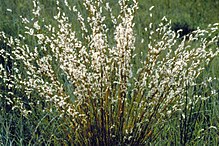The Andropogoneae, sometimes called the sorghum tribe, are a large tribe of grasses (family Poaceae) with roughly 1,200 species in 90 genera, mainly distributed in tropical and subtropical areas. They include such important crops as maize (corn), sugarcane, and sorghum.[2] All species in this tribe use C4 carbon fixation, which makes them competitive under warm, high-light conditions.[3]
| Andropogoneae | |
|---|---|

| |
| Andropogon scoparius | |
| Scientific classification | |
| Kingdom: | Plantae |
| Clade: | Tracheophytes |
| Clade: | Angiosperms |
| Clade: | Monocots |
| Clade: | Commelinids |
| Order: | Poales |
| Family: | Poaceae |
| Clade: | PACMAD clade |
| Subfamily: | Panicoideae |
| Supertribe: | Andropogonodae |
| Tribe: | Andropogoneae Dumort. (1824) |
| Subtribes | |
|
12 subtribes, see text | |
| Synonyms[1] | |
| |
Andropogoneae is classified in supertribe Andropogonodae, together with its sister group Arundinelleae. Subdivisions include 12 subtribes, but the position of several genera within them is still unresolved (incertae sedis). Hybridisation was probably important in the evolution of the Andropogoneae, and the tribe's systematics are still not completely resolved.[3] From the morphological point of view, the merging of the former subtribe 'Dimeriinae' (having solitary spikelets borne in 'robust' raceme rachis ) into the subtribe Ischaeminae (having paired spikelets borne in 'fragile' raceme rachis) is doubtful. Affinities within the tribe are complex and still under investigation.[4] Mr. Shahid Nawaz, a grass specialist at the Blatter Herbarium, is working on the phylogenomics of the tribe from India.[citation needed]
According to preliminary phytogeographic research on the tribe by MS Kiran Raj, Peninsular India, home to 54 genera (incl. 9 endemic genera, viz., Bhidea, Lophopogon, Glyphochloa, Pogonachne, Trilobachne, Pseudodichanthium, Triplopogon, Nanooravia, and Manisuris) and roughly 500 species, is thought to be the primary or secondary centre of diversity for Andropogonoid grasses. About 40% of the representative taxa are exclusively endemic to peninsular India, with the highest species diversity and endemicity found in genera like Arthraxon, Chrysopogon, Cymbopogon, Dichanthium, Dimeria, Heteropogon, Ischaemum, Ophiorus, Sehima, and Themeda.[5][4]
Description
editSpikelets within the inflorescence (flower cluster) are generally arranged on spicate racemes in pairs. A fertile, unstalked spikelet is subtended by a sterile, stalked spikelet. In species where awns are present they are found on the fertile, unstalked spikelet as an extension of the lemma.[6]
Subtribes and genera
editClassification following Soreng et al. (2017).[1]
- incertae sedis
- Apluda
- Chrysopogon (syn. Vetiveria)
- Eulaliopsis
- Microstegium (syn. Ischnochloa)
- Sehima
- Thelepogon
- Arthraxoninae
- Tripsacinae
- Chionachninae
- Coicinae
- Rottboelliinae
- Chasmopodium
- Eremochloa
- Glyphochloa
- Hackelochloa
- Hemarthria
- Heteropholis
- Jardinea
- Lasiurus
- Loxodera
- Manisuris
- Mnesithea
- Ophiuros
- Phacelurus (syn. Thyrsia)
- Ratzeburgia
- Rottboellia (syn. Coelorachis)
- Thaumastochloa
- Ischaeminae
- Germainiinae
- Saccharinae
- Agenium
- Asthenochloa
- Cleistachne
- Erianthus
- Eriochrysis (syn. Leptosaccharum)
- Euclasta (syn. Indochloa)
- Eulalia
- Hemisorghum (syn. of Sorghum?)
- Homozeugos
- Imperata
- Lasiorhachis
- Leptatherum (syn. Polliniopsis)
- Miscanthidium
- Miscanthus (syn. Diadranthus, Rubomons, Triarrhena, Tenacistachya)
- Narenga
- Polytrias
- Pseudodichanthium
- Pseudopogonatherum
- Pseudosorghum (syn. of Eulalia?)
- Saccharum
- Sarga
- Sclerostachya
- Sorghastrum
- Sorghum (syn. Vacoparis)
- Trachypogon
- Tripidium
- Veldkampia
- Andropogoninae
- Anadelphia
- Andropogon (syn. Hypogynium)
- Bhidea
- Bothriochloa
- Capillipedium
- Clausospicula
- Cymbopogon
- Dichanthium
- Diectomis
- Diheteropogon
- Elymandra
- Eremopogon
- Exotheca
- Heteropogon
- Hyparrhenia
- Hyperthelia
- Iseilema
- Lakshimia
- Monocymbium
- Parahyparrhenia
- Pseudanthistiria
- Schizachyrium
- Spathia
- Spodiopogon (syn. Eccoilopus)
- Themeda
See Also[edit]
editReferences
edit- ^ a b Soreng, Robert J.; Peterson, Paul M.; Romaschenko, Konstantin; Davidse, Gerrit; Teisher, Jordan K.; Clark, Lynn G.; Barberá, Patricia; Gillespie, Lynn J.; Zuloaga, Fernando O. (2017). "A worldwide phylogenetic classification of the Poaceae (Gramineae) II: An update and a comparison of two 2015 classifications". Journal of Systematics and Evolution. 55 (4): 259–290. doi:10.1111/jse.12262. hdl:10261/240149. ISSN 1674-4918.
- ^ Also called "kaoliang": "Shensi", in The Columbia-Viking Encyclopedia (1953), New York: Viking. Another spelling is "gaoliang."
- ^ a b Soreng, Robert J.; Peterson, Paul M.; Romschenko, Konstantin; Davidse, Gerrit; Zuloaga, Fernando O.; Judziewicz, Emmet J.; Filgueiras, Tarciso S.; Davis, Jerrold I.; Morrone, Osvaldo (2015). "A worldwide phylogenetic classification of the Poaceae (Gramineae)". Journal of Systematics and Evolution. 53 (2): 117–137. doi:10.1111/jse.12150. hdl:11336/25248. ISSN 1674-4918.
- ^ a b Kiranraj, MS (2008). "Taxonomic revision of the subtribe Dimeriinae Hack of Andropogoneae Panicoideae Poaceae in Peninsular India". Shodhganga : a reservoir of Indian theses @ INFLIBNET.
- ^ Raj, Kiran, MS, M. Sivadasan and N. Ravi (2003). Grass Diversity of Kerala Endemism and its Phytogeographical Significance. In MK Jananrdhanan & D. Narasimhan (Eds.) Plant diversity, Human welfare and conservation. Goa: Goa University. pp. 8–30.
{{cite book}}: CS1 maint: date and year (link) - ^ Skendzic, Elizabeth; Columbus, J. Travis; Rosa, Cerros-Tlatilpa (2007). "Phylogenetics of Andropogoneae (Poaceae: Panicoideae) Based on Nuclear Ribosomal Internal Transcribed Spacer and Chloroplast trnL–F Sequences". Aliso: A Journal of Systematic and Evolutionary Botany. 23 (1): 530–544. doi:10.5642/aliso.20072301.40. Retrieved 14 April 2020.